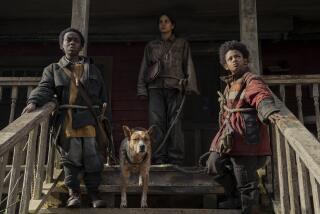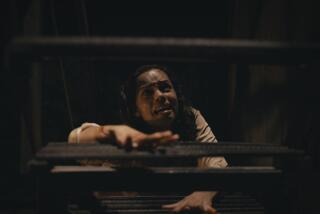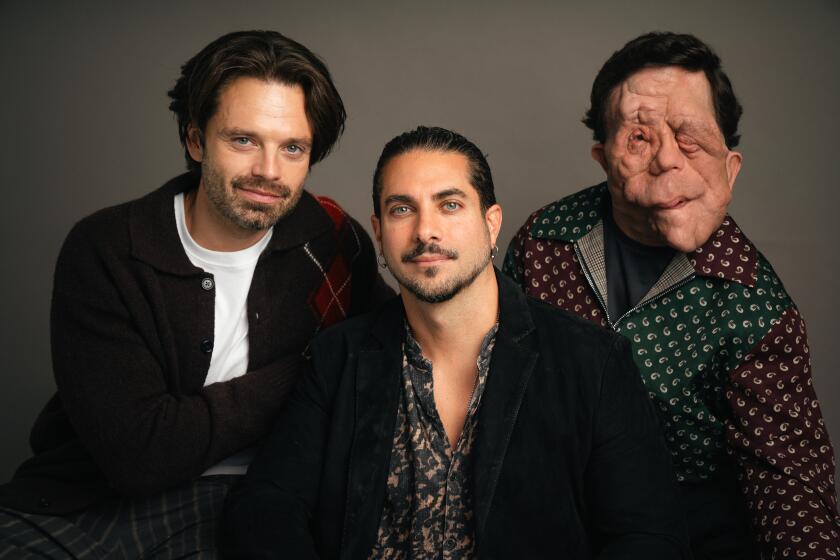Taking a deep look at horror
FOR SWEDISH director Tomas Alfredson, the eyes have it -- that scary quality just right for horror.
So when Alfredson set out to make the eerie film “Let the Right One In,” about the friendship that develops between two adolescents -- one of whom happens to be a vampire -- he didn’t watch any horror movies for inspiration. Instead, he studied paintings to see how they used “eye-to-eye contact,” he says. “I studied Renaissance painters; one, called Hans Holbein, has a very strange way of dealing with eyes.”
Alfredson was especially taken with Holbein’s 1538 painting “Edward VI as a Child.” The prince, Alfredson says, “is looking outside the frame and under it. It’s very strange and very scary.”
So he decided to paint his own celluloid canvas in the Holbein manner for “Let the Right One In,” which opens Friday after winning numerous awards on the festival circuit.
“From the start, all the characters are looking out of the camera frame, and closer to the camera as the film goes along,” he says.
Pent-up anger
Adapted BY John Ajvide Lindqvist from his bestselling Swedish novel of the same name, “Let the Right One In” revolves around 12-year-old Oskar, a pale, fragile boy in a dingy apartment complex in a Stockholm suburb who must deal with constantly being bullied by his classmates. Though he’s filled with pent-up anger because of the abuse, he never acts on his feelings. All Oskar wants is a friend. Soon, his wish comes true in the form of a 12-year-old girl, Eli, who moves in next-door with her father.
Although the dark-haired ragamuffin Eli comes out only at night -- and doesn’t seem to be affected by the freezing winter temperatures -- the two become fast friends and fall into an innocent type of love. As their relationship deepens, Oskar becomes more confident and begins to stand up for himself with his tormentors. But along with Eli’s arrival comes a storm of gruesome deaths. Soon, Oskar discovers that Eli is actually a 300-year-old vampire, trapped as an adolescent.
The story in Lindqvist’s novel inspired Alfredson to make it into a film, even though he admits he has no great passion for horror films or book adaptations.
“I really think you shouldn’t do films of good books,” says Alfredson, 43, who is best known in Stockholm as a comedic film and theater director. (His most recent stage production is “My Fair Lady,” and he’s all too happy to sing a few bars from the musical in Swedish.) “The reason is that the depth of a good book is so much greater than you could possibly do on screen in 90 minutes. But this was sort of the exception.”
Alfredson adds that it was the way Lindqvist wrote about Oskar’s tormentors that drew him in the most. “It’s very hard and very down-to-earth, unsentimental,” he says. “I had some period when I grew up when I had hard times in school. . . . So it really shook me.
“Also, when bullied children are portrayed, it is always so sentimental. I don’t think it’s so sentimental for children being bullied. On the contrary, they store up a lot of very violent feelings. I think that this vampire is all the violent feelings he gets from his tormentors. . . . Maybe Eli is just a fantasy.”
Because of this, casting the film wasn’t easy. It took Alfredson nearly a year to find Kare Hedebrant to play the troubled young boy and Lina Leandersson to portray Eli.
“I think that Oskar and Eli are two sides of the same coin,” Alfredson says. “So they should really be the same character, but mirrors to each other.
“It was very complicated. I wasn’t just [trying] to find one boy and one girl; I had to find the perfect match to the same character. It is also very important they have good families and are stable persons. It is a big responsibility to carry a whole film on your 12-year-old shoulders.”
The filmmaker quickly discovered his two young stars were old souls. “Both of them are really intelligent, and you see behind Lina’s eyes an 80-year-old woman, very wise and very quiet.”
Alfredson says the children were never allowed to read the script, so they had no idea how the story would unfold.
“I read the lines to them and they learned by hearing, not by reading,” says Alfredson, who has directed children numerous times. “I think if they had read the script, it would have been too complicated for them.”
--
More to Read
Only good movies
Get the Indie Focus newsletter, Mark Olsen's weekly guide to the world of cinema.
You may occasionally receive promotional content from the Los Angeles Times.










